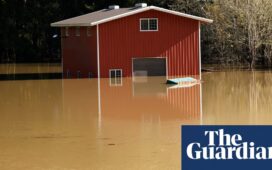Brutally hot and dry weather is forecast across much of the western United States over the Labor Day weekend. California is expected to be especially sweltering, with temperatures in some places expected to approach record-breaking highs — even though it’s September.
The state is still reeling from a heat wave last month that exacerbated a series of devastating wildfires, including the second- and third-largest fires in California history. Starting on Saturday, temperatures are expected to soar even higher than before.
This heat wave is expected to be shorter; temperatures are likely to fall on Monday. And high winds, which can fan the flames of wildfires, are largely missing from California’s weekend forecast.
But this could be a difficult weekend for people who had been planning to spend time outdoors.
“It’s a holiday weekend, so people will be wanting to travel, go camping or do outdoor activities,” said Ryan Kittell, a National Weather Service meteorologist for the Los Angeles area. “This weather is really not conducive for that.”
Temperatures in the Los Angeles area could reach their peak on Sunday, according to the Weather Service, which warned on Friday of “dangerously hot conditions” and “record temperatures likely,” with two exclamation points.
“The hottest areas will even get close to 118 degrees,” Mr. Kittell said, pointing to locations in the western San Fernando Valley. “To put that in context, the temperatures normal for this time of year were generally between 85 and 95. So we’re around 20 degrees above normal.”
People who live near the ocean may have some relief from the heat wave, said Gerry Diaz, a Weather Service meteorologist for the Bay Area. “But a lot of locations in the interior here are going to see temperatures in the low 100s — even around 110 here and there.”
Lynne Tolmachoff, a spokeswoman for Cal Fire, the state’s firefighting agency, said firefighters had been making progress on containing the blazes across the state. “There are a few that still have potential to grow, so that’s definitely a concern,” she said.
Heat waves can dry up vegetation and are often followed by stronger winds, which could exacerbate the fire risk after temperatures fall, Ms. Tolmachoff said, and firefighters are anticipating “red flag conditions” early next week.
Extreme heat is in the forecast for other western states, too, including Nevada, Utah and Arizona. In Colorado, temperatures in the Denver area are expected to reach the high 90s on Saturday and Sunday, breaking records for early September.
But a storm system is expected to bring a sharp drop in temperatures around Monday evening, possibly down to around 40 by Tuesday — and with good chance of snowfall.
Quickly changing temperatures are not new for Colorado, said Jim Kalina, a Weather Service meteorologist in Boulder. But he added that both the high temperatures in September and the potential for snow so early in the year were atypical.
Heat and weather volatility are both related to climate change, said Kristina Dahl, a senior climate scientist at the Union of Concerned Scientists, a nonprofit advocacy organization.
“The intersection of these events, like heat waves with a pandemic, are something we will increasingly expect in the future as our climate is pushed to more extreme conditions,” she added.
People who are marginalized are likely to suffer the most. Dr. Dahl noted that the same people who are more vulnerable to Covid-19 — including essential workers, people with underlying health conditions and people who cannot afford good health care or shelter — are the same people who are vulnerable in extreme heat.

